Ever since the onset of COVID-19 in India, efforts are on to understand the virus and its effects with more clarity. The latest issue of Indian Journal of Medical Research published a few of these studies. Here is a summary of the important ones.
The first COVID-19 case in India was reported on 30 January 2020. With an increase in the number of cases in subsequent months, the country went into a nation-wide lockdown in an attempt to mitigate the spread of virus and to ramp up testing and health care facilities to identify and treat the infection.
These early measures were based on the understanding of COVID-19 at that point of time and experiences from across the world. Over the last few months, India and the world are developing newer understanding of the virus, thanks to the continuous research being carried on varied aspects concerning COVID-19.
In an earlier story, we looked at some important COVID-19 research being carried out in India. We referred to the research articles published on ICMR (Indian Council of Medical Research)’s Indian Journal of Medical Research.
In this story, we look at few other research studies undertaken recently and the relevant developments in understanding COVID-19. The latest issue of Indian Journal of Medical Research has published some of these studies.
Analysis of RNA sequences show evolution of Coronavirus spread & rapid spread of one of the types across globe.
The aim of this research study was to investigate the diversification and evolution of coronavirus SARS-CoV-2, and its progression over the period of time and across geographical locations.
For this purpose, publicly available data on type definition based on whole-genome sequences of the SARS-CoV-2 between December’19 to March’2020 was considered. These samples were from 3636 patients across 55 countries. The major findings of this study are:
- Ancestral SARS COV-2 viruses of type O (that originated from China) are replaced by evolved viruses, especially type A2a.
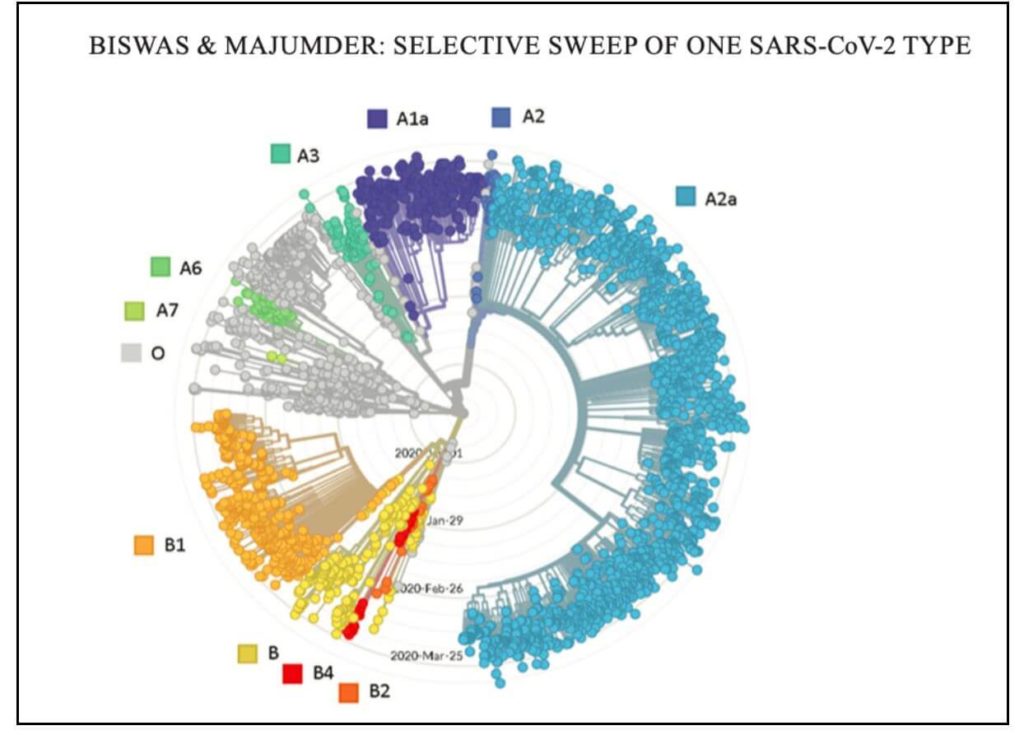
- The geographical/spatial variation is not significant with A2a type being the dominant one across.
- Micro-level variation observed within geographical regions.
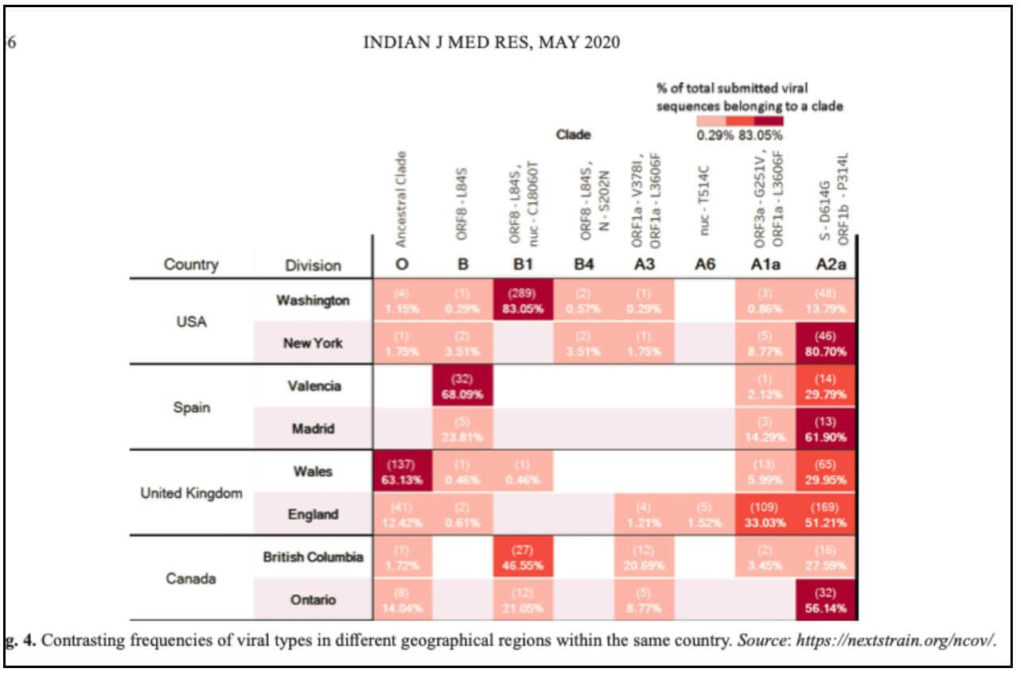
- A2a type i.e. the evolved virus is widespread across all the continents.
Based on the results from the research study, it can be understood that :
- A2a type SARS-CoV-2 possesses a variant (D614G) which eases its entry into lung cells. This could be the reason for the rapid spread across geographical regions.
- There is a need for India to sequence a large number of viral genomes regarding type and other genomic features, to determine the nature and extent of Host-Virus interaction.
- It was observed that countries with a high prevalence of infection had regional differences. It is unclear if this is due to travel patterns or ethnic composition. Hence there is a need to do this level of investigation in India as well.
- Rapid mutation and co-infection are identified with SARS-CoV-2. RNA sequencing of Coronavirus isolates can help on early identification especially in cases of co-infection with other respiratory viruses.
A recent research study by CCMB (Centre for Cellular and Molecular Biology) in Hyderabad has identified that A2a and A3I strains as being wide spread in India. This is based on the study of more than 1,573 genomes from across India, with around 2,581 variants catalogued.

National Sero-Surveillance to monitor trend & spread of Infection in India
Examples from around the world like in the case of South Korea, New Zealand show that active case finding, testing and contact tracing are key in minimising the spread of COVID-19. There is large uncertainty regarding the extent of the population that is infected by COVID-19 infection, with reports and data suggesting that a significant proportion of the infected population remain asymptomatic or pre-symptomatic.
Hence, surveillance is key in enabling tracing and testing of COVID-19 cases, but the scope would be limited if this is restricted to medical facility-based surveillance, as there are high chances that mild and asymptomatic cases are missed
Surveillance can be made more effective through household-targeted, antibody-based serologic testing, especially regarding the role of asymptomatic infection in driving transmission and would be able to effectively estimate the extant of infection in a given population.
Hence, ICMR has proposed to establish a community-based district-level Sero-surveillance system to monitor SARS-CoV2 infection in general population.
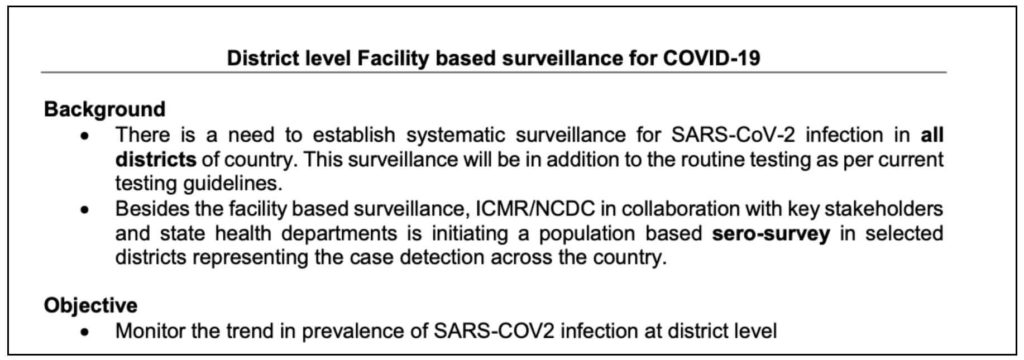
The initial survey would serve as a baseline to determine the sero-prevalence of SARS-CoV-2 infection in the community. The subsequent rounds of survey would help in monitoring the trends of infection.
The protocol for the survey is as follows
- Sampling strategy included categorization of districts in four strata based on ‘COVID-19 cases per million’. 15 districts for each stratum are selected. Further, 10 cities with the highest infection are also considered for the survey.
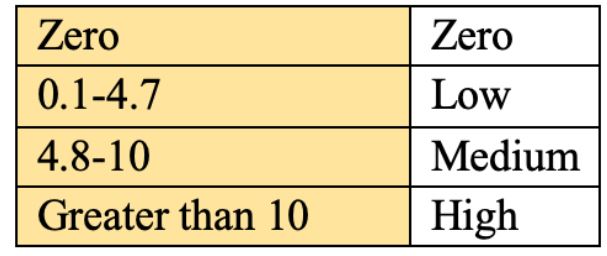
- Sample size is targeted at 6 thousand individuals for each stratum i.e. 24 thousand in total for the first round of survey.
- Sampling method included selection of 10 clusters based on 2011 census. The selection would be random.

Such a Sero-based community survey conducted in Spain was successful in providing insights about the spread of infection, especially asymptomatic cases. Finland, USA, France, Scotland, Sweden, Germany etc are among the countries which conducted serology based community surveys.
The results of the initial survey were recently announced by the government on 11 June 2020. The study found that
- 0.73% population in the districts surveyed had evidence of past exposure to SARS-CoV-2
- It has also been found that risk of infection is slightly higher in urban areas (1.09), higher in urban slums (1.89) in comparison to rural areas.
- A positive side is that infection fatality rate is very low at 0.08%.
Development of indigenous IgG ELISA for the detection of COVID-19 antibodies
Most of the diagnostic tools available for Diagnosis of COVID-19 are mainly based on Molecular assays. WHO has recommended only ‘Real-time reverse transcription-polymerase chain reaction’ as the diagnostic method to be used for COVID-19.
However, the rapid spread of the COVID-19 has created a need to use other testing methods. Serological assays are also used as a screening tool for surveillance. However, they are not recommended by WHO for case detection and are not part of WHO’s laboratory testing guidelines.
The burden of infection and the spread can be determined by using detection of IgM and IgG antibodies against SARS-CoV-2 by serological assays like ELISA (Enzyme Linked Immunosorbent Assay).
Development of such testing kits would be effective in detection and surveillance of COVID-19. ICMR-NIV (Pune) have attempted to develop and evaluate IgG-based ELISA for COVID-19.
- 513 blood samples (131 COVID-19 positive , 382 COVID-19 negative ) were collected and tested by MNT ( Microneutralization Test)
- Antigen Stock of SARS CoV-2 was prepared by propagating the virus in Vero cells.
- An IgG capture ELISA was developed for serological detection of anti-COVID-19 IgG Serum samples.
After following this method, the developed ELISA was found to be 92.7% sensitive, 97.9% specific, robust and reproducible. The Positive predictive value was 94.44% and Negative predictive value was 98.14%.
As per ICMR Journal, this indigenously developed IgG ELISA was found to be sensitive and specific for the detection of anti-COVID-19 antibodies in serum samples. This can help in determining seroprevalence of the infection in population exposed to the virus.
Suggestions for Ophthalmologists in view of COVID-19 spread
Healthcare professionals are among the high-risk individuals for contacting COVID-19. Among others medical professionals, ophthalmologists are also identified to be at high risk of being infected by COVID-19. The higher chance of risk is due to :
- Presence of virus in tear fluid – COVID-19 virus binds to ACE2 receptors, which is found in various human organs including the surface of Cornea and Conjunctiva ( the tissue that lines the inside of eyelids) and therefore act as potential entry points. The presence of virus is identified in conjunctival discharge and there is a risk of spread to fingers and instruments of the examiner.
- Proximity of the patient while treating and examining can also result in spread of COVID-19 virus.
- Conjunctivitis can also be one of the first symptoms of COVID-19, even prior to symptoms like dry cough, anosmia etc. The ophthalmologist might be treating this a generic eye related issue, unaware of the virus infection and hence being exposed to COVID-19.
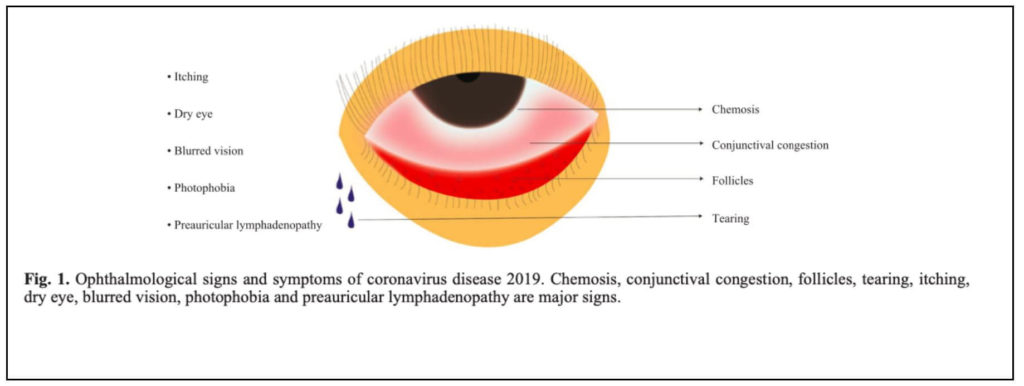
In view of this scope of risk, guidelines are being issued for Ophthalmologists to continue with their practice during this pandemic.
- Usage of Breath & eye-shields along with N95 masks especially when examining patients with fever, breathlessness but not any history of international travel or travel from COVID-19 hotspots.
- All elective surgeries to be differed.
- Urgent care to be provided for any sudden onset of painful or painless visual loss, sudden onset of squint, floaters or lid oedema.
- Patients to be recommended to discontinue contact lens if they have any symptoms of COVID-19
- Retrieval of Cornea to be avoided in case of suspect and confirmed cases.
- Retinal screenings are not required for patients taking chloroquine or hydroxychloroquine as any toxic damage to retina would be less.
- Check options for less or non-contact consultation.
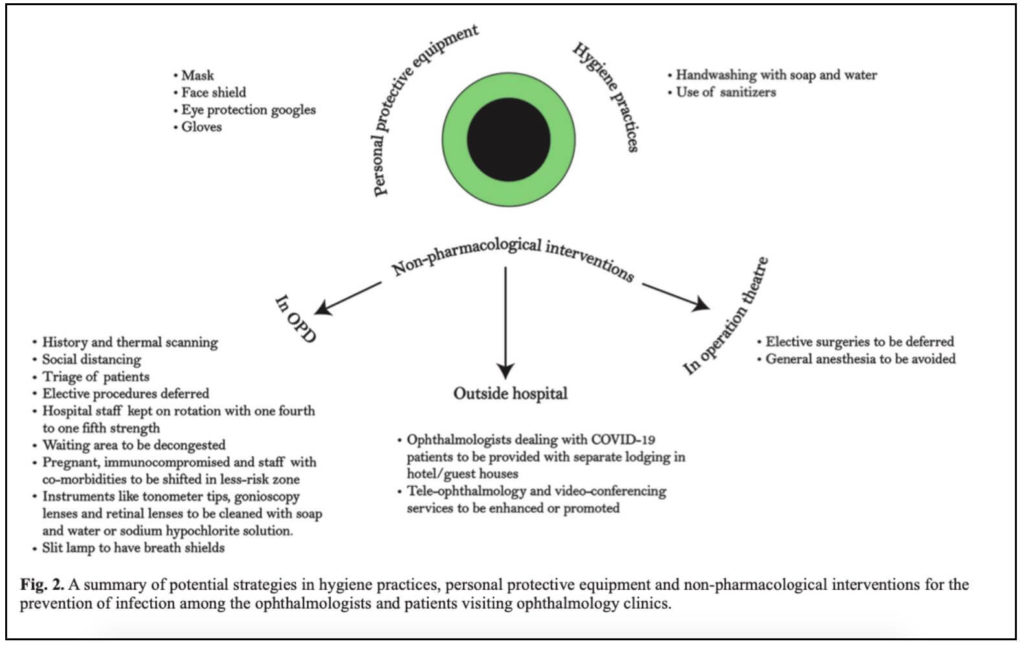
COVID-19 infection might impact multiple organs in the body
One of the initial assumptions regarding COVID-19 infection was that it effects the lungs and the respiratory system. However, as more & more COVID-19 cases are being studied, it has been observed that COVID-19 virus does infect multiple other parts in the body.
In an interview given to News agency, the Director of AIIMS has confirmed that COVID-19 does infect multiple body parts. It has been observed that COVID-19 causes inflammation in the inner lining of the blood vessels, which leads to narrowing of their area. This causes clotting and blocking of the blood vessels. In few of the cases, it has been observed that apart from lungs, kidneys have also been affected. As per a few international research studies, COVID-19 could affect Brain, Lungs, Heart, Blood Vessels, Kidneys Liver & Gut.
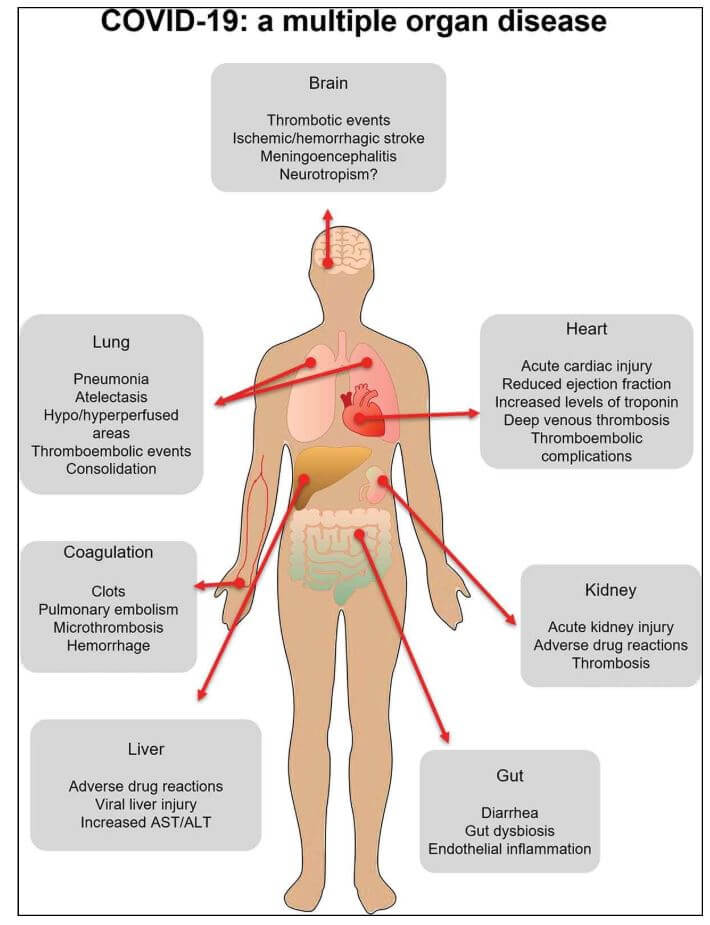
Featured Image: Studies about COVID-19


